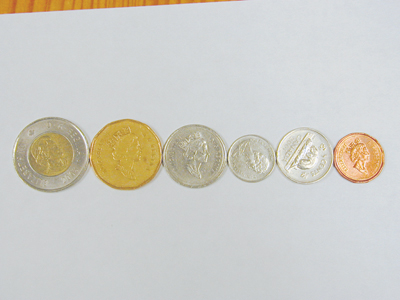
Few Canadians carry large amounts of cash with them. Expensive goods are generally paid for by cheque or through personal charge accounts. Credit cards are commonly used; many people carry more than one. Because people in this country prefer not to carry a lot of cash, Canadian banknotes most circulated are in small denominations, such as the $5 and $10 bills. Twenty-dollar bills are also frequently seen. Fifty-dollar and $100 bills are not as popular, since they are a little more difficult to change if you are not near a bank.
Canadian coins come in the form of toonies, loonies, quarters, dimes, nickels and pennies. The one-dollar coin (the loonie) gets its name from a well-known Canadian bird called the loon.) In Canada you will find small change very useful because all automated services (such as pay phones, parking meters, etc) require the exact change.
Language Notes 語文註解:
1. expensive = costing a lot of money 昂貴的
2. generally = usually 通常
3. cheque = check (American spelling) 支票
4. account = 戶口
5. credit card = 信用卡
6. commonly = often 通常
7. cash = 現金
8. banknote = bill 現鈔;紙幣;鈔票
9. banknotes most circulated = 最經常在市面上流通的紙幣
10. denomination = the face value of a coin or a banknote 錢幣或鈔票的面值
11. popular = used or preferred by many people 受人歡迎
12. change = (此處解)找換
13. toonie = 二元硬幣
14. loonie = 一元硬幣
15. quarter = 二十五分硬幣
16. dime = 十分硬幣
17. nickel = 五分硬幣
18. penny = 一分硬幣
19. loon = 加拿大雀鳥一種
20. small change =(此處解)零錢;碎銀
21. automated services = 自動化服務
22. require = ask for 按規定要求
23. exact change = payment in the exact amount 指照正確的價目付錢,不設找換






